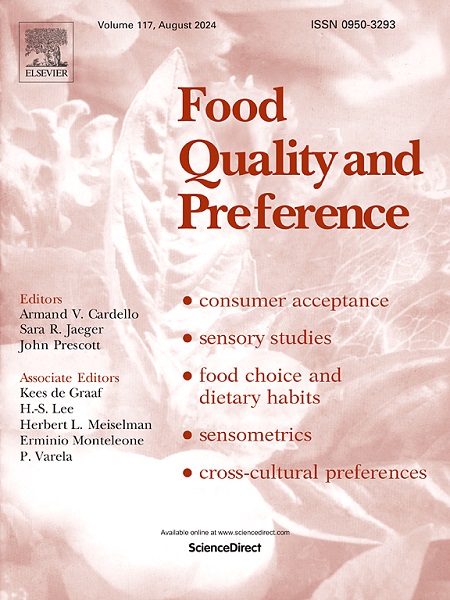Assessing moderated mediation effects influencing consumer acceptance of cell-cultured Meat: A PLS-SEM modeling approach
IF 4.9
1区 农林科学
Q1 FOOD SCIENCE & TECHNOLOGY
引用次数: 0
Abstract
Cell-cultured meat, as a novel food, is often met with limited consumer understanding, leading to a predominantly conservative attitude and lower acceptance. To gain insights into the key factors influencing consumer acceptance of cell-cultured meat, this study constructs a moderated mediation model to examine the relationship between food techneophobia (FTN), food disgust sensitivity (FDS), and acceptance of cell-cultured meat. Moreover, we investigate the mediating effects of perceived benefits (PB) and perceived risk (PR), as well as the moderating effect of information acquisition (IA). A field survey was conducted in 2020 with 4,841 Chinese consumers in households. The data were analyzed using partial least squares structural equation modeling (PLS-SEM). The findings reveal that PB is the strongest positive influencing factor of acceptance. FTN has a better predictive effect on acceptance than FDS. Both FTN and FDS can reduce PB and increase PR, thereby lowering acceptance. Partial mediation of PB and PR between FTN and acceptance of cell-cultured meat is observed, while full mediation of PB and PR exists between FDS and acceptance. IA can mitigate the negative impact of FDS on PB, thereby enhancing consumer acceptance of cell-cultured meat. This study contributes to the current literature by employing PLS-SEM as an assessment model for examining direct and mediation relationships. Understanding the factors that shape consumers’ perceptions and influnce their acceptance is essential for effective forecasting and strategic decision-making in the novel food industry.
评估影响消费者接受细胞培养肉类的调节中介效应:PLS-SEM建模方法
细胞培养肉作为一种新型食品,消费者往往对其了解有限,导致其态度保守,接受度较低。为了深入了解影响消费者接受细胞培养肉的关键因素,本研究构建了一个调节中介模型,以考察食品技术恐惧症(FTN)、食品厌恶敏感度(FDS)与接受细胞培养肉之间的关系。此外,我们还研究了感知利益(PB)和感知风险(PR)的中介效应,以及信息获取(IA)的调节效应。我们于 2020 年对 4841 个中国家庭消费者进行了实地调查。数据采用偏最小二乘结构方程模型(PLS-SEM)进行分析。研究结果表明,PB 是接受度的最强正向影响因素。FTN 对接受度的预测效果优于 FDS。FTN 和 FDS 都能降低 PB,增加 PR,从而降低接受度。在 FTN 和细胞培养肉的接受度之间存在 PB 和 PR 的部分中介作用,而在 FDS 和接受度之间存在 PB 和 PR 的完全中介作用。IA 可以减轻 FDS 对 PB 的负面影响,从而提高消费者对细胞培养肉的接受度。本研究采用 PLS-SEM 作为评估模型来检验直接关系和中介关系,为当前的文献做出了贡献。了解影响消费者认知和接受程度的因素对于新型食品行业的有效预测和战略决策至关重要。
本文章由计算机程序翻译,如有差异,请以英文原文为准。
求助全文
约1分钟内获得全文
求助全文
来源期刊

Food Quality and Preference
工程技术-食品科技
CiteScore
10.40
自引率
15.10%
发文量
263
审稿时长
38 days
期刊介绍:
Food Quality and Preference is a journal devoted to sensory, consumer and behavioural research in food and non-food products. It publishes original research, critical reviews, and short communications in sensory and consumer science, and sensometrics. In addition, the journal publishes special invited issues on important timely topics and from relevant conferences. These are aimed at bridging the gap between research and application, bringing together authors and readers in consumer and market research, sensory science, sensometrics and sensory evaluation, nutrition and food choice, as well as food research, product development and sensory quality assurance. Submissions to Food Quality and Preference are limited to papers that include some form of human measurement; papers that are limited to physical/chemical measures or the routine application of sensory, consumer or econometric analysis will not be considered unless they specifically make a novel scientific contribution in line with the journal''s coverage as outlined below.
 求助内容:
求助内容: 应助结果提醒方式:
应助结果提醒方式:


